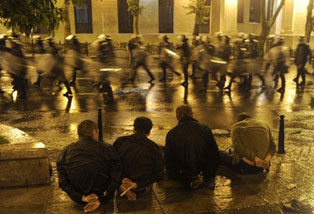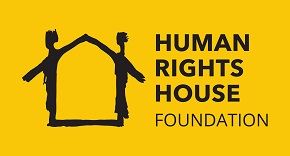Salome Achba
The Report of the Human Rights Center “Monitoring Freedom of Peaceful Assembly in Georgia – Legislation and Practice” covers monitoring of protest assemblies and manifestations from January to June 2011 in five regions of Georgia.
The report covers those violations which were committed by participants or law enforcement officers during various demonstrations. Besides that, the document presents analysis of the international and national law about assembly and manifestation. The monitoring results were presented on February 3.
The report presents the results of monitoring of total 75 assemblies held in Tbilisi, Gori, Gurjaani, Batumi and Zugdidi between January 1 and June 30, 2011. Several protest assemblies occupy particular place in the report, which were carried out through serious violations by law enforcement bodies. They were: Veteran’s Assembly (January 4, 2011) and Assembly of the Public Assembly in May. The authors separately studied the May 26 crackdown.
Policing of Assemblies
The Human Rights Center monitored 75 assemblies from January to June of 2011. In 50 of them, various police units – security police, patrol police in patrol cars, and riot police officers in rare occasions – were present during assemblies. According to the Report, law enforcement officers used force during nine assemblies; in two cases they dispersed the demonstration (Veterans’ hunger-strike demonstration on January 3 and May 26 peaceful demonstration of the Public Assembly).
The monitoring demonstrated that very often police officers observe the assemblies in civil clothes. In particular cases, they directly interfered in the manifestation process.
“There is not a hundred percent certainty when identifying them but according to our monitors it is easier after some practice of monitoring. In many cases they stand by regular police officers and interact with them. “Civilians” usually do not intervene independently and supposedly are present to acquire information or assist during the emergency,” the report reads.
The report also revealed, the “civilians” can also carry out arrests independently in urgent situations or circumstances requiring minimum public attention. This was observed on June 5, the day of the premiere of the Hollywood movie “Five Days of August” in Rustaveli Cinema. In this regard, several activists decided to deliver a message concerning the lack of freedom and democracy in the country to arriving guests. Several Hollywood stars had arrived in Tbilisi to attend the premiere. The report states that HRC monitors witnessed ten policemen in civilian clothing dragging two women across the Rustaveli Avenue, less than 100 meters from the cinema, and into the police car.
“This group of men then started to walk towards the cinema. First we thought they also were the demonstrators as they were holding folded posters but later realized that these were policemen because they approached the Tbilisi police chief Mr. Gegechkori (also in civilian clothing) shook hands with him and gave the posters”, the report reads.
The Human Rights Center’s report states there was no legal ground to arrest participants of this assembly. However, despite that the law enforcement officers arrested four participants, one of them was sentenced to ten-day administrative imprisonment and the rest were fined with 400 GEL.
The HRC Report also covers those facts when police officers seized properties from demonstrators and destroyed them. According to the Report, similar incident occurred on May 17, in front of the parliament during the hunger-strike in support of lawyers. Since the hunger strike was intended for 5 days the demonstrators had pillows, blankets, mineral water and packs of cigarettes. One and a half hours after the start of the assembly a large group of policemen advanced towards the demonstration. No resistance was observed from the side of the protesters.
The Report presents cases when demonstrators tried to provoke officers though they showed reasonable patience and restrained from acting. Specifically, on April 18 a prominent Georgian journalist Mr. Shalva Ramishvili coorganized a demonstration in front of a private cable TV company Silknet to protest against the exclusion of the opposition channel Maestro TV from the Silknet’s service package.
“Half an hour into the assembly Mr. Ramishvili crossed the street and approached the policemen observing the assembly from the distance. According to our monitor’s report Mr. Ramishvili was trying to provoke the officers. “I came here to check you out” – Ramishvili was reported saying loudly in a provocative tone. “Which one of you is Zaza Begashvili’s brother?” The police reaction was very calm as the officers did not respond in any way towards Ramishvili’s actions. As a result, Ramishvili returned to the demonstrators after few minutes. It must be noted that Mr. Ramishvili did not violate the law. He used a legal right to approach the officers in a non-violent manner,” the report reads.
A separate chapter is dedicated to the crackdown of the Veterans’ Assembly on January 3, 2011 in the Hero Square. The report states that the dispersal was illegal and the force used during the dispersal was disproportionate. The demonstrators assembled near the Hero Memorial and requested improvement of social conditions of veterans. “Police forces approached and tried to coerce the demonstrators sitting at the monument to leave the area. The detentions started after they refused to leave, answering that they were not intimidating anyone by demonstrating. The law enforcement units present at the venue included pedestrian officers, patrol officers on patrol cars and a large number of officers in civilian clothing,” the report states.
As for the crackdown of the May 26 assembly of the Public Assembly, the Report describes the process of the assembly in details as well as violations by law enforcement officers observed during dispersal. The Human Rights Center underscored several main shortcomings: blockade of surrounding territories by riot police, disproportionate number of law enforcement officers and use of disproportionate force.
The report states that police intervened into the assembly 10-15 minutes after the formal deadline of prior notification expired; thus we can argue that demonstrators did not have reasonable time to leave the area. It became impossible to leave the area when the riot police closed in from all sides. It must be noted that the riot squads did not isolate the assembly immediately after arrival. The monitoring of the Human Rights Center revealed that number of riot police officers was exceeding the number of demonstrators.
According to the HRC monitoring, the dispersal started at 00:15 am. The gas grenade launchers and water cannons were fired first together with the continuous sound of a siren. A small isolated group of armed protesters tried to resist, some even in an organized manner but were quickly overran. Overall, the resistance was not of massive character.
“As the police advanced the peaceful demonstrators abandoned their location in front of the stage and retreated towards the Parliament building but there was no escape, they were already surrounded. The policemen started to beat everybody without any discrimination. Rubber bullets were being fired from close distance and the force was used against all demonstrators regardless whether they resisted the law enforcers or not. Part of demonstrators ran into the Rustaveli Cinema seeking to escape. The riot police squads followed them there, started to beat and arrest. Human Rights Centre monitors observed the situation after the crackdown was over. Detained persons were thrown down on the road in the rain with their hands and feet tied, they were beaten and verbally assaulted by the policemen,” the report reads.
During the presentation of the HRC Report, the Public Defender of Georgia Giorgi Tugushi spoke about problems in the freedom of assembly and manifestation in Georgia. “Our state, in accordance to both international and national law, is a guarantee of freedom of assembly and manifestation, as well as freedom of expression. These rights are guaranteed by the Constitution of Georgia. The issues related with the assembly and manifestation fall under particular focus of the Public Defender. A separate chapter is always dedicated to annual reports of the Public Defender. Unfortunately, we do not have ideal situation in this field in Georgia. 2011 was quite complicated year in the sense of freedom of assembly. The rights of peaceful demonstrators were breached several times. The problem was revealed in the Report of the Human Rights Center. I am sure, we together can do much good through cooperation.”




